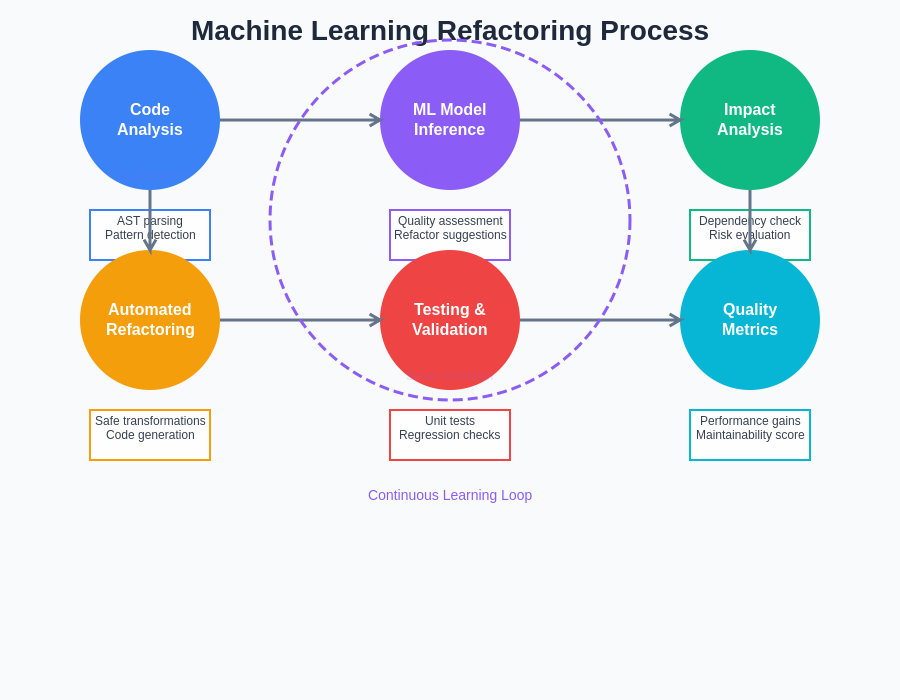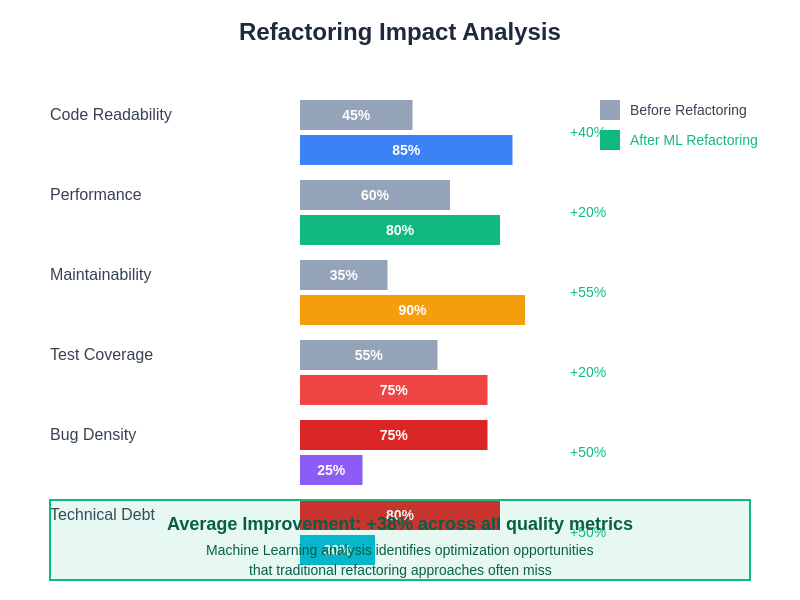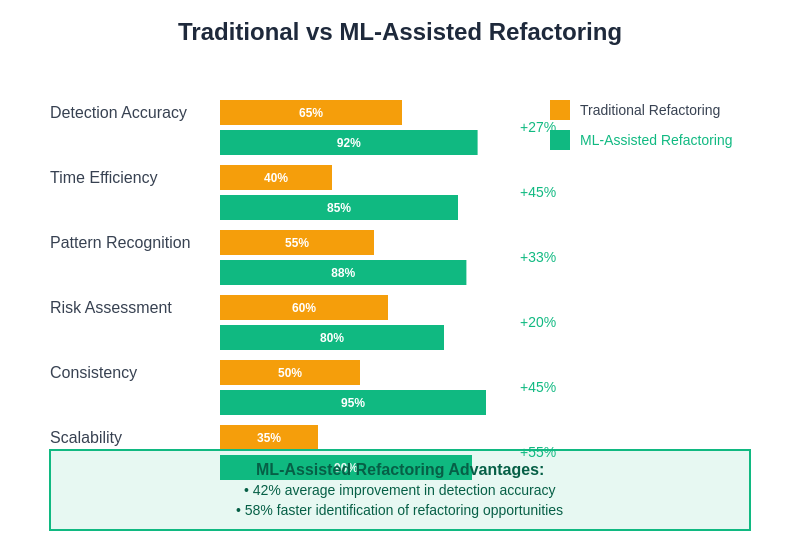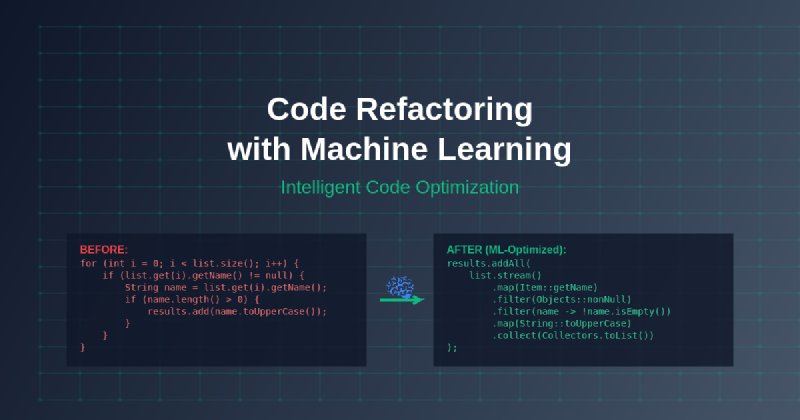The evolution of software development has reached a pivotal moment where machine learning technologies are fundamentally transforming one of the most critical aspects of maintaining code quality and system longevity: refactoring. Traditional code refactoring approaches, while effective, often require extensive manual analysis, deep domain knowledge, and significant time investment to identify optimization opportunities and implement improvements safely. Machine learning assistance has emerged as a revolutionary force that not only accelerates these processes but also uncovers refactoring opportunities that human developers might overlook, leading to more maintainable, efficient, and robust software systems.
Explore the latest AI development trends to understand how machine learning is reshaping every aspect of the software development lifecycle, from initial code generation to long-term maintenance and optimization. The integration of intelligent refactoring tools represents a paradigm shift that enables development teams to maintain high-quality codebases while significantly reducing the time and effort traditionally required for comprehensive code improvement initiatives.
Understanding Machine Learning-Driven Refactoring
Machine learning-assisted refactoring represents a sophisticated approach to code improvement that leverages artificial intelligence algorithms to analyze code patterns, identify inefficiencies, and suggest or automatically implement optimizations. Unlike traditional refactoring tools that rely on predefined rules and static analysis, machine learning systems can adapt to specific codebases, learn from successful refactoring patterns, and develop contextual understanding of code quality metrics that extend far beyond simple syntactic analysis.
The power of machine learning in refactoring lies in its ability to process vast amounts of code data, recognize complex patterns that span multiple files and modules, and correlate code changes with quality improvements over time. These systems can analyze historical refactoring successes and failures, learning to predict which refactoring strategies are most likely to yield positive results for specific code patterns and architectural contexts. This intelligence enables more targeted and effective refactoring recommendations that align with both immediate code quality goals and long-term maintainability objectives.
Intelligent Pattern Recognition and Code Analysis
One of the most significant advantages of machine learning-assisted refactoring is its capability to perform deep pattern recognition across large codebases. Traditional refactoring tools typically focus on localized improvements within individual functions or classes, but machine learning systems can identify systemic patterns that affect code quality across entire applications or even multiple related projects. These systems excel at detecting subtle code smells, architectural inconsistencies, and performance bottlenecks that might not be immediately apparent through manual code review or conventional static analysis tools.
Machine learning algorithms can be trained to recognize various types of refactoring opportunities, including dead code elimination, method extraction, class restructuring, and design pattern implementation. The sophistication of these systems allows them to understand the context in which code operates, considering factors such as performance requirements, maintainability goals, and team coding standards when generating refactoring recommendations. This contextual awareness ensures that suggested improvements align with project-specific requirements and development team preferences.
Enhance your development workflow with Claude’s advanced AI capabilities for intelligent code analysis and refactoring assistance that understands complex codebases and provides contextually relevant optimization suggestions. The combination of human expertise and machine learning intelligence creates a powerful synergy that elevates code quality while reducing the cognitive burden on development teams.
Automated Code Quality Assessment and Metrics
Machine learning systems excel at establishing comprehensive code quality metrics that go beyond traditional measures such as cyclomatic complexity or lines of code. These intelligent systems can learn to correlate various code characteristics with real-world quality outcomes, including bug frequency, maintenance effort, performance impact, and developer productivity. By analyzing historical data from successful projects, machine learning models can develop sophisticated understanding of what constitutes high-quality code within specific domains and organizational contexts.
The automated assessment capabilities of machine learning-driven refactoring tools enable continuous monitoring of code quality trends, identifying gradual degradation that might otherwise go unnoticed until it becomes a significant problem. These systems can track quality metrics over time, alerting development teams to emerging issues and suggesting proactive refactoring strategies to prevent technical debt accumulation. This predictive approach to code quality management represents a significant advancement over reactive refactoring practices that typically address problems only after they become apparent through performance issues or increased maintenance costs.
Context-Aware Refactoring Recommendations
The contextual intelligence of machine learning systems enables them to provide refactoring recommendations that consider the broader implications of code changes within the application ecosystem. These systems can analyze dependencies, usage patterns, and performance characteristics to ensure that suggested refactoring operations will not introduce unintended side effects or negatively impact system functionality. This holistic approach to refactoring recommendation significantly reduces the risk associated with code modifications while maximizing the potential benefits of optimization efforts.
Machine learning-assisted refactoring tools can also adapt their recommendations based on team preferences, coding standards, and project-specific requirements. By learning from previous refactoring decisions and their outcomes, these systems become increasingly aligned with organizational goals and development practices. This adaptive capability ensures that refactoring suggestions remain relevant and valuable as projects evolve and team expertise develops over time.
Automated Refactoring Execution and Validation
Beyond providing recommendations, advanced machine learning systems can automatically execute certain types of refactoring operations with high confidence levels. These automated refactoring capabilities are particularly valuable for routine optimization tasks such as variable renaming, method extraction, and code structure improvements that follow well-established patterns. The systems can perform comprehensive impact analysis before executing changes, ensuring that automated refactoring operations maintain code functionality while improving quality metrics.
The validation capabilities of machine learning-assisted refactoring tools extend to automated testing and verification of refactoring results. These systems can generate or execute existing test suites to confirm that refactoring operations have not introduced functional regressions while achieving the intended quality improvements. This automated validation process provides confidence in refactoring outcomes and enables more aggressive optimization strategies that might be considered too risky with manual refactoring approaches.

The systematic approach to machine learning-assisted refactoring involves continuous analysis, intelligent recommendation generation, automated execution where appropriate, and comprehensive validation to ensure that code improvements enhance both quality and maintainability without compromising functionality.
Performance Optimization Through Intelligent Analysis
Machine learning systems bring unprecedented capabilities to performance-oriented refactoring by analyzing execution patterns, resource utilization, and bottleneck identification across complex application architectures. These systems can correlate code structures with runtime performance characteristics, identifying optimization opportunities that might not be apparent through static analysis alone. The ability to learn from performance profiling data and correlate it with code patterns enables more targeted and effective performance improvements.
The intelligent analysis capabilities extend to understanding the trade-offs between different optimization strategies, considering factors such as memory usage, computational complexity, and scalability requirements when suggesting performance-oriented refactoring operations. Machine learning models can be trained to recognize patterns that lead to performance improvements while avoiding optimizations that might negatively impact code readability or maintainability. This balanced approach ensures that performance refactoring efforts contribute to overall code quality rather than creating technical debt through over-optimization.
Leverage Perplexity’s research capabilities to stay informed about the latest developments in machine learning-assisted code optimization and performance analysis techniques that are shaping the future of software development practices. The continuous evolution of these technologies promises even more sophisticated and effective refactoring capabilities in the near future.
Legacy Code Modernization and Migration
One of the most challenging aspects of software maintenance involves modernizing legacy codebases and migrating systems to contemporary architectural patterns and technologies. Machine learning-assisted refactoring tools excel at analyzing legacy code structures, identifying modernization opportunities, and suggesting migration strategies that minimize risk while maximizing the benefits of updated technologies and practices. These systems can understand deprecated patterns, outdated libraries, and architectural anti-patterns that commonly plague legacy systems.
The intelligence of machine learning systems enables them to propose incremental modernization strategies that allow for gradual system improvement without requiring complete rewrites or extensive downtime. By analyzing successful modernization patterns from similar projects, these tools can recommend refactoring sequences that have proven effective for comparable legacy systems. This evidence-based approach to legacy modernization significantly reduces the uncertainty and risk typically associated with large-scale system updates.
Team Collaboration and Knowledge Sharing
Machine learning-assisted refactoring tools contribute significantly to team collaboration and knowledge sharing by providing consistent, objective analysis of code quality and improvement opportunities. These systems can serve as neutral arbiters in technical discussions, providing data-driven insights that help teams make informed decisions about refactoring priorities and strategies. The consistency of machine learning analysis helps establish common understanding of code quality goals and refactoring best practices across development teams.
The knowledge sharing capabilities extend to capturing and disseminating refactoring expertise throughout organizations. Machine learning systems can learn from the refactoring decisions and outcomes achieved by experienced developers, making this knowledge available to less experienced team members through intelligent recommendations and educational explanations. This democratization of refactoring expertise helps raise the overall quality of code modifications across entire development organizations.
Integration with Development Workflows and CI/CD Pipelines
The seamless integration of machine learning-assisted refactoring tools with existing development workflows and continuous integration/continuous deployment pipelines represents a crucial factor in their practical adoption and effectiveness. These tools can be configured to automatically analyze code changes during pull request reviews, providing immediate feedback on potential refactoring opportunities and quality impacts. This integration ensures that refactoring considerations become a natural part of the development process rather than an afterthought or separate activity.
The continuous monitoring capabilities of machine learning systems enable them to track code quality trends over time, identifying gradual degradation that might require proactive refactoring attention. Integration with CI/CD pipelines allows for automated quality gates that can prevent the introduction of code that significantly degrades overall system quality while suggesting specific refactoring actions to address identified issues. This proactive approach to quality management helps maintain high standards throughout the development lifecycle.

The comprehensive impact analysis capabilities of machine learning systems enable development teams to understand the full implications of refactoring decisions, including effects on performance, maintainability, testability, and overall system architecture.
Advanced Code Pattern Detection and Transformation
Machine learning algorithms excel at detecting complex code patterns that span multiple files, modules, or even entire applications. These systems can identify architectural patterns, design anti-patterns, and opportunities for pattern-based refactoring that might require extensive manual analysis to discover. The ability to recognize patterns at various levels of abstraction enables more comprehensive refactoring strategies that address both localized code quality issues and broader architectural concerns.
The transformation capabilities of machine learning-assisted refactoring tools extend to implementing sophisticated design patterns, architectural improvements, and code structure optimizations that require deep understanding of software engineering principles. These systems can suggest and implement refactoring sequences that gradually transform code toward more maintainable, testable, and extensible architectures while preserving existing functionality and performance characteristics.
Quality Prediction and Technical Debt Management
One of the most valuable capabilities of machine learning-assisted refactoring is its ability to predict future code quality issues and technical debt accumulation based on current code patterns and historical trends. These predictive capabilities enable proactive refactoring strategies that address potential problems before they manifest as significant maintenance burdens or performance issues. By analyzing patterns that have historically led to quality problems, machine learning systems can recommend preventive refactoring actions that maintain code health over time.
The technical debt management capabilities extend to quantifying the impact of various refactoring strategies on long-term maintenance costs and development productivity. Machine learning models can be trained to correlate code quality metrics with real-world development outcomes, providing objective measures of technical debt and the potential return on investment for different refactoring initiatives. This quantitative approach to technical debt management helps organizations make informed decisions about resource allocation and refactoring priorities.
Customization and Domain-Specific Optimization
Machine learning-assisted refactoring tools can be customized and trained for specific domains, programming languages, and organizational contexts to maximize their effectiveness and relevance. These systems can learn from domain-specific best practices, coding standards, and quality requirements to provide more targeted and appropriate refactoring recommendations. The ability to adapt to specific organizational contexts ensures that refactoring suggestions align with established practices and strategic goals.
The domain-specific optimization capabilities extend to understanding industry-specific requirements such as regulatory compliance, security standards, and performance criteria that may influence refactoring decisions. Machine learning systems can be trained to recognize patterns that support these requirements while identifying refactoring opportunities that enhance compliance and security posture. This specialized knowledge ensures that refactoring efforts contribute to overall organizational objectives rather than focusing solely on generic code quality metrics.
Future Directions and Emerging Capabilities
The field of machine learning-assisted refactoring continues to evolve rapidly, with emerging capabilities promising even more sophisticated and effective code improvement tools. Advanced natural language processing techniques are enabling systems that can understand and respond to high-level refactoring goals expressed in natural language, making these tools more accessible to developers with varying levels of technical expertise. The integration of large language models with code analysis capabilities is creating new possibilities for intelligent code transformation and optimization.
The future development of machine learning-assisted refactoring tools will likely focus on improved contextual understanding, better integration with development environments, and enhanced ability to handle complex, multi-language codebases. These advances will further reduce the barriers to adopting systematic refactoring practices while increasing the sophistication and effectiveness of automated code improvement capabilities.

The comparative advantages of machine learning-assisted refactoring over traditional approaches demonstrate significant improvements in efficiency, accuracy, coverage, and overall effectiveness of code improvement initiatives.
Best Practices for Implementation and Adoption
Successful implementation of machine learning-assisted refactoring requires careful consideration of organizational context, team capabilities, and project requirements. Organizations should begin with pilot projects that demonstrate the value and effectiveness of these tools while building confidence and expertise within development teams. The gradual introduction of machine learning-assisted refactoring capabilities allows teams to adapt their workflows and develop best practices for integrating AI assistance with human expertise.
The adoption process should include comprehensive training and education to help developers understand how to effectively collaborate with machine learning systems and interpret their recommendations. This educational component is crucial for maximizing the benefits of AI-assisted refactoring while maintaining human oversight and decision-making authority over critical code changes. The combination of human judgment and machine intelligence creates the most effective approach to systematic code improvement.
The transformation of code refactoring through machine learning assistance represents a fundamental shift in how development teams approach code quality and system maintenance. These intelligent systems provide unprecedented capabilities for analyzing, understanding, and improving complex codebases while reducing the time and effort required for comprehensive refactoring initiatives. The continued evolution of machine learning technologies promises even more sophisticated and effective tools that will further enhance the ability of development teams to maintain high-quality, maintainable software systems throughout their entire lifecycle.
Disclaimer
This article is for informational purposes only and does not constitute professional advice. The views expressed are based on current understanding of machine learning technologies and their applications in code refactoring. Readers should conduct their own research and consider their specific requirements when implementing AI-powered refactoring tools. The effectiveness of machine learning assistance may vary depending on specific use cases, codebase characteristics, and organizational contexts.
